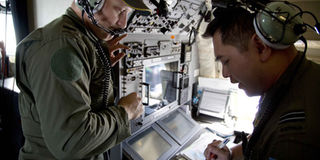New search for MH370 if vessel fails

PHOTO | AFP Crew members aboard a Royal Australian Air Force AP-3C Orion aircraft observe navigation maps as they search for missing Malaysian Airlines flight MH370 over the southern Indian Ocean on March 27, 2014.
What you need to know:
- Australia sees new Phase of looking for jet if mini-sub does not succeed in a week
- If the best leads now being pursued to locate wreckage from the Boeing 777 prove fruitless, said Prime Minister Tony Abbott, the search would not be abandoned but enter a new phase.
PERTH, Australia, Thursday
The hunt by a mini-submarine for a Malaysian airliner in the uncharted depths of the Indian Ocean — the latest phase in a huge international search — will end in about a week, Australia says.
If the best leads now being pursued to locate wreckage from the Boeing 777 prove fruitless, said Prime Minister Tony Abbott, the search would not be abandoned but enter a new phase.
The US Navy’s Autonomous Underwater Vehicle (AUV) Bluefin-21 is the newest tool deployed in the hunt, after satellite data and electronic signals from the plane’s black box helped narrow the search area.
But the unmanned torpedo-shaped sonar mapping device is operating at the extreme limit of its range, and has twice had to cut short its mission.
“We believe that (sub) search will be completed within a week or so,” Abbott told Thursday’s Wall Street Journal in an interview as the device mapped the seabed 2,000 kilometres (1,240 miles) off the western Australian city of Perth.
“If we don’t find wreckage, we stop, we regroup, we reconsider.”
The AUV Thursday completed its first full mission at the third attempt, officials said, and was readying to dive again. Data it retrieved was being analysed.
The first two part-completed missions failed to produce any results.
Malaysia Airlines Flight MH370 vanished on March 8 on a flight from Kuala Lumpur to Beijing with 239 people on board.
The cause of its disappearance, after being diverted hundreds of kilometres off course, remains a mystery. No debris has been found despite an enormous search involving ships and planes from several nations.
“My determination for Australia is that we will do whatever we reasonably can to resolve the mystery,” Abbott said.
“If the current search turns up nothing, we won’t abandon it, we will simply move to a different phase,” he was quoted by the Journal as saying, reiterating his confidence that searchers were looking in the right place.
After more than three weeks of listening for signals from the black box flight recorder, the sub was deployed for the first time on Monday night but aborted the mission after breaching its 4,500m operating limit.
An unexplained technical problem cut short the second mission, raising questions about the whole search, which is expected to be further complicated by thick silt on the seabed.
The Bluefin is being deployed from the deck of the Australian vessel Ocean Shield, which has led the search.
Before Abbott’s comments the US Navy estimated it would take the Bluefin-21 “anywhere from six weeks to two months to scan the entire search area”.
Australia’s Joint Agency Coordination Centre (JACC) has repeatedly called for patience and warned the search will be a long, laborious process.
“Bluefin-21 has searched approximately 90 square kilometres (35 square miles) to date and the data from its latest mission is being analysed,” JACC said.
JACC chief Angus Houston has stressed that the mini-sub cannot operate below 4,500 metres and that other vehicles would have to be brought in to cope with greater depths.
Experts have said these could include remotely operated vehicles that can go as deep as six kilometres.





